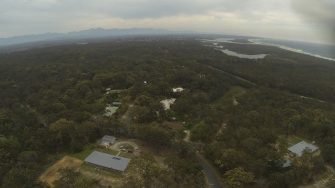
Date: Tuesday, October 7, 2014
Project: Eastern Australian Waterbird Survey
Observer: Richard Kingsford
Off again on our 32 second year surveying waterbirds across a third of the continent. The southerly has just hit Sydney before we took off, dropping temperatures which means fewer hot air bumps but the wind also blows our small aeroplane about a bit. Today – we did our first part of the ‘coast leg’, with only a little actual surveying. Mostly we head north on the path of all small aircraft, along the east coast beaches. The sea is calm and so we spotted a couple of pods of migrating whales, breaching out of the water on their southern journey. Our survey bands stretch east to west from the Northern Territory border to the coast. So as we head up the coast, we survey the most eastern parts of our 30 km wide survey bands. It’s always exciting to see the same places year in year out. First on our survey list are the Myall Lakes, including Wallis Lake.
Photo 1. Surveying Wallis Lake, taken from a gopro camera on the wing
These massive coastal lakes lie just inland of the coast in Myall Lakes National Park. Swans and cormorants are all we usually see and today was no different. The swans graze on the seagrass beds in the shallows while pied and great cormorants dry their wings in the dead trees around the lake, taking off in flocks of up to 50 as we fly close by. I had expected more cormorants and swans, given the dryness of inland Australia. After refuelling at Port Macquarie, we next survey the Bellinger River, which is on Band 5, where we saw a few eastern curlews but little else in the way of waterbirds. Often there are areas just north of the river, with waterbirds but not today. We will pick up survey band 5 again on the way back to Sydney on about the 16th October.
Photo 2. Surveying the Bellinger River, near Bellingen
Band 5 stretches all the way to Lake Eyre when it has water but we will probably see our first water out west on this band, around the Paroo overflow lakes east of the town of White Cliffs. The next survey band, number 6 going north, is just north of Byron Bay. Coastal wetlands here that often have water are dry with water now only in the estuaries and rivers. From here, we head for Maroochydore with Band 7 just to the north, on tomorrow’s survey plan. From Byron, we skirt the Gold Coast flying over the wonderful hinterland rainforests. A strong northeasterly wind buffets our plane a bit as it hits the range. We spot a couple of fires, their smoke blown south by the strong winds.
Photo 3. The Gold Coast high rise buildings
Leaving the manicured canal estates, towering buildings and Seaworld behind on the Gold Coast, we had a wonderful flight over Stradbroke Island. This is always one of the thrilling sites of this coastal leg when we are spot our first turtles. From our height, they look like tiny ants floating lazily in the shallow lagoons. The azure coloured water also shows the dark long bodies of the odd shark cruising the shallows. We were even lucky to see a couple of dugongs along with shipwrecks. Overnight stop at Maroochydore.
Photo 4. South Stradbroke Island looking east out to sea
Photo 5. Shallows of North Stradbroke Island where turtles were swimming
Photo 6. It was very low tide, creating great patterns in the shallow
Photo 7. The shipwrecks on the northwestern side of North Stradbroke Island
